Our trip to Paris was about the sights, sounds, and smells of the city just as much as it was about the museums and historical monuments. We didn't just learn things aboutParis; we were able to experience Paris in a way only possible through direct interaction with the city. We became veterans of the metro system. We really tried to notice all the everyday unextraordinary things that made the city what it was. Here we present to you our impressions.
Our "Tentatives d'Epuisement des Lieux Parisiens"
A la Perec.
In his novel Tentative d'épuisement d'un lieu Parisien published in 1975, French-born writer Georges Perec (1936-1982) does just what the titles implies: he attempts to describe everything he notices from his seat in a coffee shop at the Place Saint-Sulpice in Paris. Things and events, he says, which no one would otherwise bother writing about. Thus, he notes the numbers on the passing buses, how full they are, the postal office across the street, the cars parked in front of the coffee shop, or the passersby, all unsuspecting heroes in a story in progress. The result: a story in real time so authentic, so common, the reader truly feels he or she is sitting with Mr. Perec, sipping black coffee, while he writes.
Il y a beaucoup de choses place Saint-Sulpice, par exemple : une mairie, un hôtel des finances, un commissariat de police, trois cafés dont un fait tabac, un cinéma, une église à laquelle ont travaillé Le Vau, Gittard, Oppenord, Servandoni et Chalgrin et qui est dédiée à un aumônier de Clotaire II qui fut évêque de Bourges de 624 à 644 et que l'on fête le 17 janvier, un éditeur, une entreprise de pompes funèbres, une agence de voyages, un arrêt d'autobus, un tailleur, un hôtel, une fontaine que décorent les statues des quatre grands orateurs chrétiens (Bossuet, Fénelon, Fléchier et Massillon), un kiosque à journaux, un marchand d'objets de piété, un parking, un institut de beauté, et bien d'autres choses encore.
We found such a method of writing fascinating. So, while in Paris, we were challenged to attempt the same Tentative on our own, and to write à la Perec. Each of us, armed with a journal and pen, marched to a chosen spot, where we proceeded to create our own work of art. Of all lessons, we first realized that writing about ordinary things and events is much harder than one would think. Nevertheless, we managed to come up with a few sentences describing the happenings immediately around us. Following are our own interpretations of lieux parisiens in the Perec style. Compare for yourself and see how we fared on this challenge!
Selected excerpts from the participants' journals:
Alexis - Carrie - Jenny - Punya - Rossana
For more information on George Perec and his works, please refer to some of the following links:
http://www.kirjasto.sci.fi/perec.htm
http://www.associationperec.org/
http://www.rfi.fr/fichiers/langue_francaise/Perec/les_lieux.asp
Le Métro
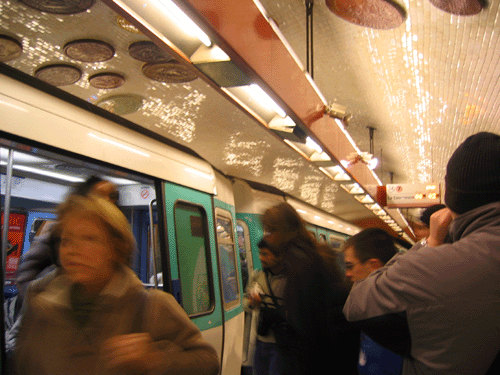
First opened on July 19, 1900 with the present day line 1 (Porte de Vincennes to Porte Maillot and La Défense), Paris' metro system is a really efficient way of getting around. The trains are super fast and the stations are relatively clean. Although there are 14 lines altogether, there is very little confusion when it comes to switching lines and utilizing the metro because each direction is clearly marked. Also, there is not much of a wait between trains, and the self-service doors are pretty neat. You can get off the train quicker since you operate the door right when you need to get off, and getting onto the train is faster too. No time wasted waiting for the doors to automatically open/close!
The metro is mostly underground, but there are a few open-air stations. Notably, line 6 (Charles de Gaulle–Etoile to Nation) travels above ground for quite some time, affording the rider a great view of the city from the swiftly-moving train.
[train from Cambronne to La Motte Piquet Grenelle: see video (avi)]
[musician plays aboard metro; view of la Tour Eiffel: see video (avi)]
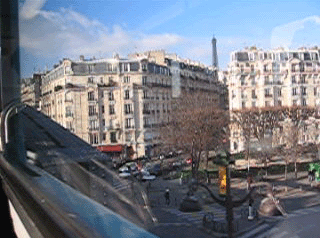
Carrie's favorite part of the metro: the musicians who perform in the stations. It isn't unusual to come across a 16-member ensemble playing a famous classical piece, right in front of the trains! If you frequent Châtelet, a busy station where many metro lines intersect, you might come across a scene like this...
[an underground orchestra: see video (avi)]
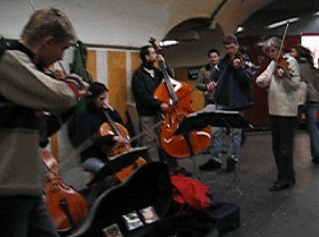
Weekly passes which come with La Carte Orange (an orange ID card) and a metro ticket cost 14.50 euros for zones 1 and 2, and will get you most anywhere in Paris. The weekly passes go from Monday through Sunday, so a new one should be purchased on the Monday of each week, and the Carte Orange/weekly pass allows you to not only use the metro, but also the RER and buses. Packs of 10 single use tickets are also sold for 10 euros, and a day pass can be bought for 5.20 euros.
The entire metro system consists of 199 km (124 miles) of tracks and 368 stations, 87 of which serve as interchanges between lines. There is at least one metro station within 500 meters of any building in Paris, and around 6 million people ride the metro each day. In 1999, the metro was made up of 3500 cars and 15,000 employees. In general, the public transportation system of Paris is very impressive. The ease, quality, and speed of Paris' public transportation make traveling in and around Paris the very least of your worries.
Nightclubs / Boites de Nuit
An overview by Alexis.
Paris has many amazing nightclubs and bars. We only got to visit a select few, but here are some of the highlights of this year's trip.
Alcazar
Called "Paris's most high-profile brasserie de luxe," Alcazar is an artistic and high-tech bar featuring all-white futuristic décor in a bar overlooking a large street-level dining room. The drinks are stylish and pricey (8-16 Euro), and the trendy crowd tends to wear a lot of black. Conveniently, it is located in the left bank, right on Rue Mazzarine.
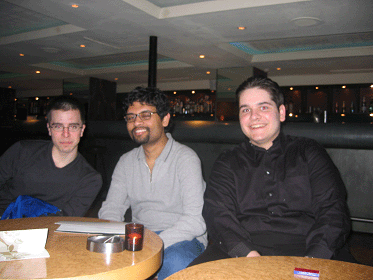 |
We finally got Sebastian and Punya to come out with us! Michael looks stylish as usual. |
|
Alexis and friends from high school enjoy being trendy in black, while Carrie chooses to remain an individual. |
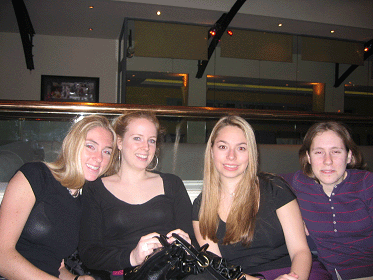 |
Man Ray
This club is my personal favorite in Paris. Owned by Johnny Depp, Sean Penn and John Malkovich and located right off the Champs-Elysées, this former cinema is now filled with golden Buddhas, oriental antiques, and photos by the famous Dadaist, Man Ray. Entrance fee was 20E including first drink. The edges are surrounded with private tables with never-ending champagne bottles in hot pink Moet ice buckets, but if you prefer the bustling dance floor in the center you may even run into... ELTON JOHN! Rosanna and Alexis spotted the famous singer at the club and minutes later found themselves being videotaped by French TV. Music is typical European club music (electronic) -- nothing American here!
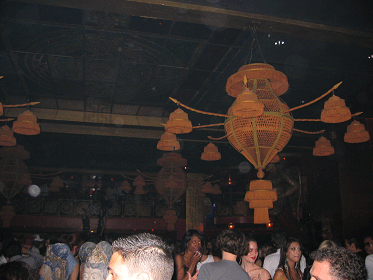 |
View of Man Ray from the side tables. Bar in Mezzanine level. |
|
Alexis and friend Genevieve having fun on the dance floor. |
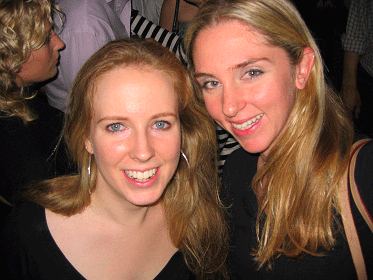 |
V.I.P. Room
Owned by the famous Jean-Roch, we were told before going that this is the most difficult club to get into in Paris. You better be dressed right (not too trashy) or have a lot of money, otherwise this female bouncer will throw you right back onto the Champs-Elysées. An iron gate with the bouncer is right off the main street, but the club is found further inside down a long set of stairs leading to a lounge with animal print rugs and plush antique chairs containing the coat check, leading to another long set of stairs down to the dance floor. The music is more hip-hop, and there is less of a traditional dance floor area, with lots of little tables and posts for dancing around... or on. Not really my style (too elitist), but fun. Entrance is 25E.
[ www.viproom.fr ]
Queen
This usually gay club on the Champs-Elysées is a must-see on Mondays for its disco nights, which bring people of every sexuality to its long lines. Its glitzy entrance of flashing lights leads to an almost completely black interior that is mostly dance floor, with an exclusive, gated platform with tables and champagne overlooking the dancing. On disco night you'll find people dressed up in everything from jeans, to 70s gear, to all black, but most notably everyone is really into the music. Entrance is 20E.
[ www.queen.fr ]
Other clubs to try: La Suite (owned by David Guetta), Le Buddha Bar, Le Paris, Le Barrio-Latino
Marchés de Paris
Impressions by Carrie.
I didn't want to discover what visiting Paris was like; I wanted to discover what living in Paris was like. I wanted to get out in the streets, chat with the locals, haggle. I found out about the following marchés (markets) from l'Officiel des Spectacles, a weekly guide to Paris goings-on (look under "autres curiosités" for marchés, promenades, and other places to explore).
Marché Parisien de la Création
Ca, c'est un marché en plein air à Montparnasse. Cent artistes sont là tous les dimanches pour présenter et vendre directement leurs œuvres. Il y a des peintures et les sculptures très vives et variées.
Je ne suis arrivée que quinze minutes avant la fermeture du marché, mais j'ai reussi à voir la plupart de ce qu'il y avait. Il faisait nuit, mais il y avait les lampes fortes qui donnaient beaucoup de lumière sur les tableaux. Je voulais prendre quelques photos, mais j'ai rapidement appris que les artistes n'aiment pas les photographes trop près de leurs œuvres. J'ai decidé de respecter leurs vœux et de ne pas montrer les photos ici!
Marché du livre ancien et d'occasion
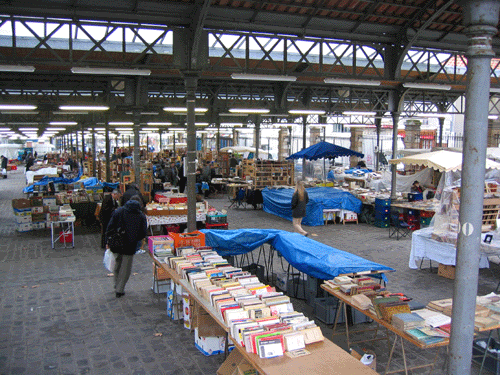
Apparently, people who like old books also like pipes. This is what I've learned from my trip to the Marché du livre ancien et d'occasion. It's an outdoor market with books as far as my camera could see, complete with cigar-toting vendors puffing away every few steps. I liked it so much I stayed there for three hours, shivering and huddling as the cold seeped into my bones. Once I got cold through and through, I fought with myself whether to stay or to leave. There were just so many books... I don't know if I couldn't seen them all if I'd had the whole day. (The marché is open from 8 a.m. to 7 p.m., for those interested in taking on the challenge!) The tents were so large that I felt like I was in a giant disorderly library -- I think only the cold reminded me I was outside. And the smell -- the damp air and the thousands, millions of books soaked with mustiness and cigarette smoke from today and so many such samedis and mercredis over the centuries.
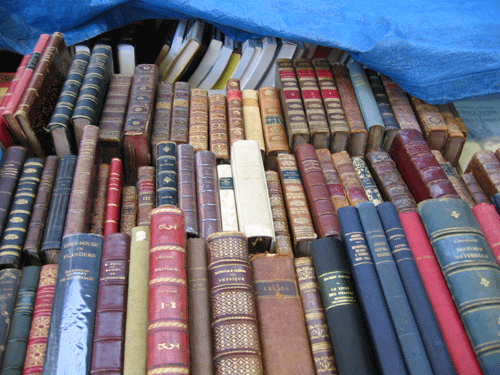
The way the pipes smelled, they could have been centuries old, too -- the exhalations of the corpses of the great writers whose works were scattered about here. I managed to duck away, usually, down the next row past tables of first edition comic books and a sedate-looking dog on a leash. The books here range from last year's one-dollar pocket novel to those old faded comic books to really old books whose age you can't guess, bound in tough brown leather or painted with gold. They just don't make books like that anymore, books where the cover doesn't even show the name of the book, just a dusty, delicate spiral design that looks like it was made by hand, dipping paper in swirls of colored oil, inspired by peacock feathers. The spines are where the names are, text going horizontally along the short axis, riddled with hyphens.
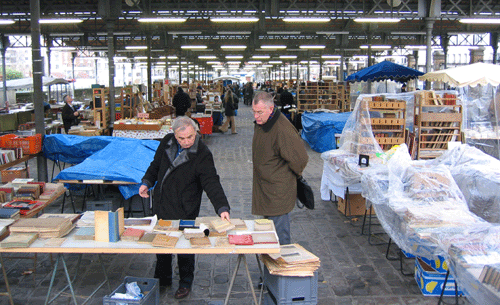
My company was mostly old men with gray hair and gruff expressions and those bloody pipes. There were a few walking around and nodding at me, some absorbed in a newspaper, and one sleeping in his chair like it was his own porch. Nobody noticed when I finally slipped out, past the stacks and a man selling flowers near the gate exit.
Marché aux puces
Marché aux puces means (quite literally) flea market. There are several of them in Paris, and I had chosen the Marché aux Puces de Clignancourt, all the way at the north end of the city.
This is another marché I didn't reach until after nightfall. I came up from the underground metro station clutching my map, but as I crossed the street the way became evident -- there was a steady stream of people going away from and towards a huge mass of tent-like structures. The darkness made it a bit ominous, although that could have also been the large size and the bustling, slightly raucous crowd. I found mostly clothing for sale there, though there were such more extravagant items as picture frames and large exotic paper-covered lamps that I wouldn't've been able to take home with me if I'd wanted to. I'd been expecting a smaller, quainter, odder selection of goods, though I shouldn't've been surprised by the insistent vendors hawking their wares. In the end I came away without buying anything, and I have to admit that I was a little relieved to escape the tightly-packed droves to the relative peacefulness of the metro train. Next time I'll visit in the daylight...
Other marchés I never got to visit (la prochaine fois!): Marché aux oiseaux, Cité. Marché aux fleurs, Cité. Marché aux Vieux Papiers de Saint-Mandé (cartes postales, timbres, livres, documents, etc.), St-Mandé-Tourelle.
Survival guide
Everyday Paris survival tips from Jenny.
1. Watch out for buses and cars: they will most likely NOT stop for you. Despite a recent law requiring vehicles to always stop at crosswalks, in practice, pedestrians seldom have the right of way.
2. Watch out for les crottes de chien (dog poop) on the streets!
3. Beware of pickpockets, especially in Montmartre: don't go near the guys who sell "Friendship Bracelets" at Sacre Coeur. They'll rob you before you know it (we saw them being arrested and stolen goods being confiscated).
4. Walk right past anyone who says they'll do something for you (i.e. draw a quick portrait for you, take a photo for you), especially if they SAY it's free… remember, NOTHING of this sort is free.
5. Have an umbrella handy.
6. Unless you want to be yelled at by your friendly foreign neighbors, don't talk with your hotel door open at midnight.
7. Remember the exchange rate. If it's not in the dollar's favor, keep in mind that you may be spending more than you think!
8. In France, the electric plugs are 220V. Get an adapter before you get here, but don't fret if you didn't bring one. The front desk at your hotel might have a few to lend out.
9. Expect your legs to get the workout of their lives. There's lots of walking to do, and running if you're late for an appointment.
10. Stock up on beverages at the nearest supermarket during the day because most places close earlier than in the U.S. and you don't want to be stuck in your room thirsty. Plus, individual beverages are pretty expensive at restaurants.
11. Make sure to do your shopping during the day. As mentioned previously, even department stores close earlier than at least I'm used to.
12. Most camera shops are closed on Sundays so get film/memory cards worked out before.
13. When you're at a restaurant, ask before you order! You wouldn't want to end up with something unpleasantly unexpected on your plate!
14. Don't take the RER late at night if you're alone. Because there is more time between stations, there's more time for you to be mugged. Take the metro instead which usually only takes 1-2 minutes between stops.
